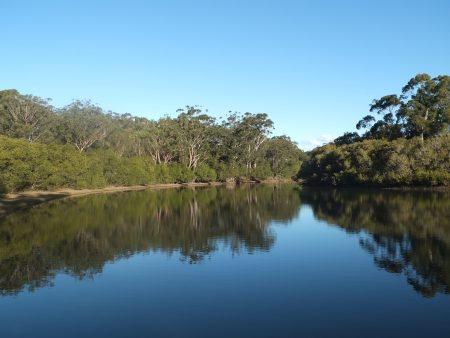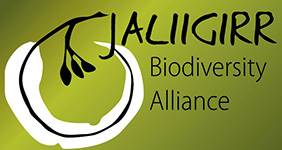This Vision for the Coffs Creek Catchment is the result of an aboriginal community planning workshop, which was part of a Community Action Grant in 2011/12, funded by the Australian Government.
Our vision for the catchment and the waterways within it and their management is:

– For a healthy and productive ecosystem where plants and animals provide an abundance of food, medicine and fibre to the whole community.
– That our community re-develop and strengthen our cultural connections and Gumbaynggirr tradition and knowledge about this part of our world.
– That this creek system provides economic opportunities for our people.
– That this area continues to nurture our spirits and provide enjoyment and serenity.
– That the impacts of agriculture and urbanisation are minimised and the creek system is buffered from those impacts.
– That the aboriginal community is supported in their contribution to and participation in the management of the area in partnership with other management agencies.
Buluunggal – sea mullet
“I tell you, here, one time ago, like, the sea mullet, when they come along, you get the white butterfly. They come and swarm, they fly through, and they say, “Oh, the sea mullet’s close.” Sure enough, a coupla days after, along come the sea mullet. … They used to fly north, just ahead of the sea mullet, just before winter they’d come in.” (Paul Taylor)
“They were that thick, the waves could hardly break. And sharks, big sharks ‘d follow, low tide, and hey was that thick, miles long, just black with mullet.” (Bruce Laurie)
Today – the present
Places
Coffs Creek – Buluunggal – in Coffs Harbour continues to play an important role in the local aboriginal culture. Important places here are where people lived and still enjoy visiting:
The Old Camp (Fitzroy Oval), the Showground, the Cemetery, the Botanic Gardens, the Ranch, Happy Valley, Ferguson Cottage and Muttonbird Island.
Camp sites were important places of transition and survival. (refer to Aboriginal Landscapes Assessment and Protection study for more information)
Aboriginal Community-owned lands
Coffs Harbour & District Local Aboriginal Land Council (CHALCL) own 15 residential properties in the catchment, providing housing for 23 families. CHALCL also own 7 ha of bushland along Coffs Creek, which are managed for conservation.
A number of Aboriginal Land claims are outstanding.
Land & Water Management:
Coffs Harbour City Council (CHCC), the Coffs Harbour Repair to Country team (Darrunda-Wajaar) and Friends of Coffs Creek are actively involved in the management of the catchment. CHCC have developed a plan of management for all reserves in the catchment and a plan of management for the whole catchment is currently under development (see Other Plans).
Concerns are: Water quality – in particular impacts from stormwater and agricultural run-off and siltation. Rubbish – Up to 2400 kg of rubbish (mostly plastic) is collected by volunteers in one year.
Economic opportunities
The Darrunda-wajaar ‘Repair to Country’ team is gaining bush regeneration contracts with a variety of local agencies and this facilitates further training for team members, which in turn opens other job opportunities for these young people.
The Office of Environment & Heritage employs a local aboriginal man as Discovery Ranger on a casual basis (Mark Flanders). His tours of ‘Muttonbird by Moonlight’ are very popular and successful and a canoe tour for Bulunggal is in the planning.
Tomorrow – the future
Place names
The local aboriginal community would like to see a number of place names changed to honour local identities and Gumbaynggirr culture:
Coffs Creek to Buluunggal (Gumbaynggirr for mullet)
Coffs Creek Tributary to Snake Gully
Bangalore Bridge to Thomas Flanders Snr Bridge (1st aboriginal grave digger in Coffs Harbour)
Rothsay Reach viewing platform to Pasaltis Place
We would like the Gumbaynggirr name for this area to be used more often in honour of the aboriginal history of the region – Garlambirla
Carpet Snake – Artist Shaa Smith
Traditional knowledge
The totem for this creek is the carpet snake. We intend to ensure the continuity of local aboriginal culture, to honour traditional knowledge and foster aboriginal identity, respect for tradition, history and place. Collect and pass on traditional uses of bush foods, medicine and fibre, harvesting times and methods and fishing traditions.
Celebrate Buluunggal as a food bowl, a spiritual place and a place of transition and survival.
Amenities
Improve amenities, in particular on the northern side of Coffs Creek, taking into consideration places where our elders would like to rest. Improve water-based access. Locate a toilet on the northern side of the creek, preferably near Rosella Street.
Economic / employment opportunities
Buluunggal has economic value as a food bowl and potential for the development of eco-tourism activities. The Aboriginal community would like to develop these opportunities for bird-watching and canoeing activities and guided walks with stories and examples of traditional uses of the plants and animals.
Land & Water management
We would like to see sustainable catchment management for a productive ecosystem with well vegetated creek banks which buffer the water environment from urban impacts as best as possible. Restoration and conservation work within the riparian zones of the creek and its tributaries needs to integrate traditional aboriginal values and uses. The creek system has the potential to connect the mountain range with the ocean environment for wildlife movements and exchange of fresh and saltwater ecosystems and the management of the system needs to promote and support good connectivity.
Water quality data collection must be used to identify hotspots and target remediation works (see Other Plans).
We want to foster and encourage aboriginal volunteerism in the restoration of our natural environment (Caring for Country).
Supporting Actions
Ideas for deepening cultural awareness and appreciation
– Promotion of the beginning of the (Sea) Mullet Run in March.
– Create a cultural celebration event (Buluunggal Festival), possibly coinciding with another aboriginal cultural event, such as Harmony Day or Close the Gap Day (late March).
– Involve schools to foster intergenerational transfer of knowledge. Include art and music as well as bush foods/medicines.
– Promote bush foods with cooking classes.
– Link with Coffs Ambassador Program to add aboriginal history to the Coffs Creek Walk tour.
Economic opportunities
Further develop profile and capacity of the ‘Repair to Country’ team with specialised knowledge of this coastal environment.
Create Mullet Festival, based on the creek environment and cultural connections.
Exploit existing employment support programs for aboriginal people and community organisations:
– Aboriginal Employment Strategy http://www.aes.org.au/
– Elsa Dixon Aboriginal Employment Programhttp://www.training.nsw.gov.au/programs_services/funded_other/acp/edaep.html
– Indigenous Wage Subsidy (IWS) http://www.deewr.gov.au/indigenous-wage-subsidy-iws
– Promote and encourage volunteerism in aboriginal community
– Actively participate in CHCC public consultation process for Coffs Creek Coastal Zone Management Plan.
– Promote and encourage volunteerism to Care for Country.
– Engage ‘Repair to Country’ team in project development.
– Encourage extractive industries in particular as well as other businesses to contribute financially to environmental projects.
– Liaise with Coffs Harbour City Council on project development for Coffs Creek, using CHCC Environmental Levy Program.
– Exploit existing funding opportunities for the management, conservation and protection of natural resources:
NSW Environmental Trust ‘Protecting Our Places’ program www.environment.nsw.gov.au/grants/pop.htm
Australian Government ‘Caring for our Country’ program
Indigenous Protected Areas
Coffs Harbour City Council Environmental Levy program
Organisations involved with the management of Coffs Creek
Coffs Harbour City Council- Recreational Services (Parks & Gardens). Sue Stewart, email: sue.stewart@chcc.nsw.gov.au, ph 6648 4875
Coffs Harbour ‘Repair to Country’ team – Coffs Harbour & District Local Aboriginal Land Council. Lisa White, email:darrunda-wajaarr@hotmail.com, ph 6652 8740 & 0429 637 212
Friends of Coffs Creek – Member of Coffs Harbour Regional Landcare. Elisabeth Edwards, ph 6651 5380.
– Attendance list for Aboriginal planning for Coffs Creek
Supporting documents
– Coffs Harbour City Council 2013 – Draft National Resource Management Plan for Coffs Harbour City Council Lands adjoining Coffs Creek
– Coffs Harbour City Council 2013 – Coffs Creek Coastal Zone Management Plan
– Coffs Harbour City Council Liz Thomas, 2013 – Aboriginal history of the Coffs Harbour region
– Coffs Harbour City Council 2007 – Coffs Creek Flying-fox Camp Strategy and Vegetation Managament Plan
– Ecological Australia 2010 – Aboriginal Landscapes Assessment & Protection Project for Northern Rivers Catchment Management Authority
– Megan Goulding, 2001 – Cultural Places, contested spaces. A study of Aboriginal peoples’ historical attachments to landscape. Coffs Harbour Region Cultural Heritage Study for Cultural Heritage Division, NPWS, NSW.
– David Scott, 2012 – Monitoring vertebrate fauna within coastal Coffs Harbour Shire, 2010 -2012. NSW National Parks Association – Coffs-Bellingen Branch.
– Bird species recorded at Botanic Gardens-1
– Fish species in Coffs Creek Estuary
– Threatened Ecological Plant Communities species in the Coffs Creek catchment
– Local Bush food and medicine plants
Project funding
This project was funded by the Australian Government under its Caring for our Country program 2011.
Coordinated by Coffs Harbour Regional Landcare





